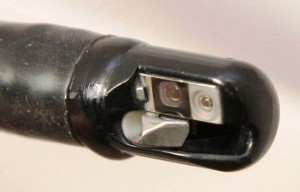April 19, 2016 — A hospital in the Lehigh Valley Health Network identified at least two patients last year who might have been exposed to an endoscope contaminated with a ‘superbug,’ according to today’s Allentown Morning Call.
The Morning Call newspaper also printed a second article that provides my guidance for patients concerned about becoming infected with a dangerous bacteria while undergoing endoscopy, particularly “ERCP” or “EUS.”
Along with this Morning Call’s guidance, I provide additional advice for the public in the section, below, entitled: “Questions to ask your doctor” (click this text to jump to that section).
“Endoscopy” is a general term that describes a medical procedure that uses a flexible endoscope to view certain internal organs, such as the esophagus or the colon. Endoscopes feature a camera, lens and a light source, among other components.
Hospitals within the Lehigh Valley Health Network include Lehigh Valley Hospital-Muhlenberg (Bethlehem, PA), Lehigh Valley Hospital-Cedar Crest (Allentown, PA) and Lehigh Valley Hospital-Hazleton (Luzerne County, PA).
What is ERCP?
ERCP — or “endoscopic retrograde cholangiopancreatography” — is a type of endoscopic procedure commonly used to diagnose and treat diseases of the upper gastrointestinal tract, including certain digestive ducts.

Ducts are small, narrow tube-like structures of tissue through which digestive fluids — such as bile — flow into the duodenum.
Once there, these fluids (with the help of enzymes) break down foods, like fats, so they can be absorbed into the body. The cystic duct and common bile duct are examples of these digestive ducts (see insert).
The types of superbugs — also called multidrug-resistant bacteria — that have infected patients in U.S. hospitals during endoscopy, especially during ERCP, include resistant strains of E. coli, Klebsiella and Pseudomonas.
The superbug that has garnered most of the attention the past year amid concerns about the patient’s safety during ERCP is “CRE,” or carbapenem-resistant Enterobacteriaceae.
The mortality rate of patients infected with a superbug during ERCP can be as high as 50% — that is, one out of every two infected patients may not survive.
Despite this high mortality rate, Pennsylvania’s Health Department does not maintain records on superbug infections in Pennsylvania hospitals, including those associated with contaminated endoscopes, the Morning Call reported.
Colonoscopy, which is performed using a colonoscope, has not (to date) been linked to superbug infections.
What is a duodenoscope?
ERCP is performed more than 650,000 times a year in the U.S. using a flexible endoscope called a duodenoscope, which is inserted into the patient’s mouth, passed through the stomach, and into the first part of the small intestines called the duodenum.
Performed along with a technique called fluoroscopy, ERCP provides clinicians with real-time, x-ray video images of the patient’s digestive ducts.
On occasion, these ducts can become obstructed by, for example, a cancerous tumor or a gallstone, hindering the flow of certain digestive fluids into the duodenum, as required for digestion.
Blockages of these ducts can cause pain (in the upper right side of the abdomen) and jaundice (or, yellowing of the skin).
A relatively non-invasive procedure that can be life-saving, ERCP can be used to re-open these blocked ducts, relieve the pressure, and drain out the backed-up digestive fluids, so that proper digestion of certain foods can resume.
The Lehigh Valley Health Network primarily uses duodenoscopes and echo-endoscopes manufactured by Olympus America (Center Valley, PA) to perform approximately 950 ERCP and EUS procedures a year, in total, at its Cedar Crest and Muhlenberg campuses, according to the Morning Call.
The newest Olympus duodenoscope referred to as the TJF-Q180V model was recalled earlier this year amid safety concerns.
What is EUS? And what is an echo-endoscope?
EUS, or “endoscopic ultrasound, is another type of procedure also used to diagnose and treat certain diseases of the digestive tract.
EUS may be used to drain a pseudocyst, or to sample cancerous tissues (a biopsy) of the digestive tract, among other clinical applications.
This procedure is performed using a echo-endoscope — another type of flexible endoscope that emits and receives high-frequency sound waves (ultrasound) to produce detailed images of the lining and walls, and surrounding tissues and organs, of either the upper and lower digestive tract.
For reference, whereas the esophagus and stomach are parts of the upper digestive tract, the colon is in the lower digestive tract.
A recent regulatory alert by an endoscope manufacturer emphasizes that potentially deadly superbug infections are not exclusive to duodenoscopes, but may also be transmitted to patients during EUS.
“Forceps elevator mechanism”

Both duodenoscopes and echo-endoscopes feature a mechanical component, or “lifter,” at their distal end (see insert).
The physician uses this lifter — also known as a forceps elevator mechanism — to manipulate and control the direction of important accessories, such as guide-wires and needles, that are threaded through the endoscope’s accessory channel.
Deadly superbug outbreaks
Examples of U.S. hospitals that linked duodenoscopes and/or echo-endoscopes to superbug outbreaks since 2012, with associated morbidity and mortality, include the following centers (each of whose outbreaks I have reported):
- UCLA Ronald Reagan Medical Center, (Los Angeles, CA)
- University of Colorado Hospital (Aurora, CO)
- Huntington Memorial Hospital (Pasadena, CA)
- Charlotte Health System (Charlotte, NC)
- University of Pittsburgh Medical Center- Presbyterian (Pittsburgh, PA)
- Advocate Lutheran General Hospital (Park Ridge, IL) and
- Virginia Mason Medical Center (Seattle, WA), among a number of other U.S. hospitals.
 Two of these deadly outbreaks were published on the front pages of The Denver Post and The Los Angeles Times. Both articles include my perspectives and advice about the risk of infection during endoscopy (see inserts on right).
Two of these deadly outbreaks were published on the front pages of The Denver Post and The Los Angeles Times. Both articles include my perspectives and advice about the risk of infection during endoscopy (see inserts on right).
 FDA safety alerts
FDA safety alerts
The FDA issued a safety advisory in February 2015 that alerted the public for the first time that endoscopy is a risk factor for superbug infections.
According to the FDA, endoscopes featuring an elevator mechanism, especially duodenoscopes, “may impede effective reprocessing” as a result of a faulty endoscope design.
This FDA advisory stressed that “the moving parts of the elevator mechanism contain microscopic crevices that may not be reached with a brush,” potentially exposing patients to life-threatening superbug infections during ERCP (and EUS).
Superbug infections following endoscopy are not exclusive to ERCP and EUS, however, and have also been linked to bronchoscopes (which are used to diagnose and treat diseases of the lungs) and to cystoscopes (which are used to diagnose and treat disease of the urinary tract).
And, neither of these types of flexible endoscopes features the elevator mechanism about which the FDA has expressed most of its concerns, indicating that the design of this mechanism is not the only contributor to infection.
(Article continues below).
![]() Confidential Safety and Legal Reviews for Hospitals, Manufacturers and the Public: Click here to read about Dr. Muscarella’s quality and safety services committed to assisting manufacturers, hospitals and patients reduce the risk of healthcare-associated infections, including ‘superbug’ outbreaks linked to contaminated duodenoscopes.
Confidential Safety and Legal Reviews for Hospitals, Manufacturers and the Public: Click here to read about Dr. Muscarella’s quality and safety services committed to assisting manufacturers, hospitals and patients reduce the risk of healthcare-associated infections, including ‘superbug’ outbreaks linked to contaminated duodenoscopes.
What is “reprocessing”?
Reprocessing — or, the cleaning and disinfection of reusable medical equipment — is a multi-step process that is crucial to prevent the transmission of infectious superbugs during endoscopy.
However, even if hospitals clean and disinfect duodenoscopes and echo-endoscopes as instructed by their manufacturers, these endoscopes can still expose patients to potentially deadly bacteria, according to the FDA. Patients have been infected by endoscopes reprocessed either manually or using an automated washing machine.
The Lehigh Valley Health Network, like most U.S. hospitals, uses automated washers to clean and disinfect endoscopes, according to the Morning Call article. These washers are more commonly called automated endoscope reprocessors, or “AERs.”
Last November and then again this past January, the FDA ordered the recall of a popular AER used by hospitals in Pennsylvania and throughout the U.S.
Read my advice, below, in the section entitled: “Questions to ask your doctor.”
U.S. Senator Patty Murray (D-WA)
Earlier this year, in January, Patty Murray, a U.S. Senator from Washington (state), published a report that echoed some of the concerns about endoscopes that the FDA discussed it its safety advisory issued in February 2015.

The Senator’s report found that at least 16 different U.S. hospitals since 2012 had traced antibiotic-resistant infections directly to contaminated duodenoscopes, although none of these hospitals whose infected patients expired notified the FDA.
The Lehigh Valley Health Network notified the FDA of its potential outbreak last year, according to the Morning Call, but the network declined to provide the newspaper with a copy of the report for independent verification.
There’s many reasons why the public needs to know whether a hospital has linked a superbug outbreak to ERCP. Patients would want the option to undergo the procedure at another hospital. Unfortunately, what we’re learning is health care is much more of a business than we thought, and it’s much less transparent than we thought. — Lawrence Muscarella, PhD (From: The Allentown Morning Call).
In general, hospitals only notify the FDA if a patient dies following exposure to a contaminated endoscope.
Sen. Murray’s report was also critical of the FDA’s oversight of medical devices, concluding that the Agency’s current system for identifying superbug infections linked to contaminated endoscopes is inadequate and outdated.
In response to the difficulty cleaning and ensuring the safety of duodenoscopes, last January Olympus recalled its newest and most popular duodenoscope model — the Olympus TJF-Q180V.
Olympus manufacturers 85 percent of the duodenoscopes used in the U.S. to perform ERCP. The other two manufacturers are FUJIFILM Medical Systems (Wayne, NJ) and PENTAX Medical (Montvale, NJ).
Hospital care is about integrity, compassion and honesty — not silence. — Lawrence Muscarella, PhD (From: Pasadena Star News)
Despite this recall, the majority of U.S. hospitals perform ERCP using the Olympus TJF-Q180V model (pending its repair by Olympus, reportedly by this August).
According to the FDA, Olympus’ recalled duodenoscope has infected or exposed as many as 350 patients at 41 different medical facilities in the U.S. and worldwide since 2010 to a superbug during ERCP, with a significant number of these infected patients dying.
Ordinarily, hospitals notify patients (during the informed consent process) that “infection is a known complication of ERCP” — not likely, and of greater importance, that ERCP poses a significantly increased risk of transmitting potentially deadly superbug infections, including CRE.
Nor is the patient ordinarily informed prior to undergoing ERCP that the procedure may be performed using an recalled endoscope whose design the FDA has been found to be faulty.
Infection risk under-reported
CNN reported last April that, according to a congressional investigation, the number of potentially deadly infections from contaminated duodenoscopes “is far higher than what federal officials previously estimated.”
To date, the transmission of deadly superbugs during EUS (performed using an echo-endoscope), in contrast to ERCP (performed using a duodenoscope), has not received the same publicity, despite the infection risk.
Featured content — Questions to ask your doctor about the infection risk
I provide the following advice for patients scheduled to undergo ERCP (or EUS).
Several of these listed recommendations are featured in the Morning Call newspaper and are intended to further reduce the risk of a bacterial infection during either digestive procedure:
• Talk with your doctor about your condition and ensure that ERCP (or EUS) is necessary.
- Keep in mind that both procedures can be life-saving. If your doctor recommends that the procedure be performed promptly, do so understanding that the risk of a bacterial infection (while higher than currently acknowledged) remains relatively low.
• If your doctor concludes the procedure is elective, not urgent, however, discuss whether there are other options to treat your digestive condition, or whether ERCP can be delayed until Olympus has repaired all of its recalled duodenoscopes (this “fix” will reportedly be completed by this August, and my recommendation assumes that the hospital uses an Olympus duodenoscope, which is quite possible).
• If you are scheduled to undergo an out-patient endoscopic procedure (and will be leaving the hospital the same day as undergoing the procedure), contact your physician two to three days after the procedure if you experience any significant discomfort or pain (in the upper right or middle section of the abdomen), or if you are displaying symptoms of a possible bacterial infection, such as a fever and chills.
It’s not that anyone’s challenging the merit of the ERCP. It’s that some may challenge inadequate oversight of the instruments used to perform the ERCP. — Lawrence Muscarella, PhD (From: The Allentown Morning Call
• Review the informed consent form the hospital will ask you to sign prior to undergoing endoscopy, and confirm that it discloses (if the following are not included on the form, consider asking that they be added):
- that the procedure poses an increased risk of infection from bacteria that may be resistant to certain antibiotics;
- whether your endoscopy will be performed using the recalled Olympus TJF-Q180V duodenoscope (or another type of medical device that has been recalled or has been otherwise been recently censured by the FDA);
- whether the hospital identified one or more of its patients who were infected with a multidrug-resistant bacteria following ERCP or EUS within the past two years; and
- that, if it identifies (in the next year or two) a patient who might have been exposed or infected with a superbug during ERCP or EUS, the hospital will inform you and discuss with you your risk of infection, and offer you the opportunity, if advisable, to be tested for a superbug infection.
• Ask your physician what specific measures the hospital has taken to prevent future bacterial infections, if the hospital has identified any patients infected with a multidrug-resistant bacteria following ERCP or EUS within the past two years.
[As discussed in The Los Angeles Times, Denver Post and The Seattle Times, hospitals that have identified a bacterial outbreak following endoscopy may not notify the infected patients about the outbreak and its possible cause.]
• Confirm that the hospital performs one or more of the following important measures, which are recommended by the FDA to reduce the risk of infection:
- the hospital routinely cultures duodenoscopes to ensure they are not contaminated with a superbug before reuse; AND/OR
- the hospital sterilizes duodenoscopes using ethylene oxide (EO) gas before reuse; AND/OR
- the hospital cleans and high-level disinfects duodenoscopes at least twice before reuse.
If the hospital does not perform at least one of these measures, bring this to your doctor’s attention and ask what other measures the hospital has taken to ensure your safety during ERCP (or EUS).
• Almost all U.S. hospitals use an automated endoscope reprocessor (or, “AER”) to clean and disinfect endoscopes.
- Therefore, ask your doctor or hospital to ensure that the endoscope that will be used to treat you — particularly if its is sold by Olympus — will be thoroughly reprocessed using a legal (not recalled or federally censured) AER.
- The following FDA webpage provides a list of those AER models that have been validated for reprocessing duodenoscopes. (If the hospital’s AER is not listed, ask your doctor what measures the hospital has taken to ensure your safety during ERCP and EUS.)
• Consider asking the hospital to test you (at the hospital’s cost) to confirm that you are not infected or colonized with a superbug prior to your undergoing EUS or ERCP. Any infections that you contract shortly after the procedure could therefore be due to the endoscopic procedure, which would be important for you to know.
• Become an educated consumer and learn as much as you can about your medical care. Ask your doctor any and all questions. No question is a bad question. (You may email me with your questions: Email: Larry@LFM-HCS.com).
[I provided some similar recommendations to prevent superbug infections in an article by KPCC Radio 89.3 entitled, “Ask these questions to avoid the superbug.”]
“[Back to top]” (Click the link to return to the beginning of this article).
Final remark
By asking questions of your physician and hospital to ensure quality medical care, you, the patient, will be improving the safety of health care and contributing to reducing health care costs — a “win-win” scenario.
 Article by: Lawrence F Muscarella, PhD. Posted June 19, 2016. Updated: June 28, 2016, Rev A.
Article by: Lawrence F Muscarella, PhD. Posted June 19, 2016. Updated: June 28, 2016, Rev A.
LFM Healthcare Solutions, LLC. All rights reserved. Dr. Muscarella is an internationally known medical safety expert and national spokesman for endoscope safety. He is the president and owner of LFM Healthcare Solutions, LLC (Montgomeryville, PA), an independent company.
E: Larry@LFM-HCS.com. Twitter: @MuskiePhD
